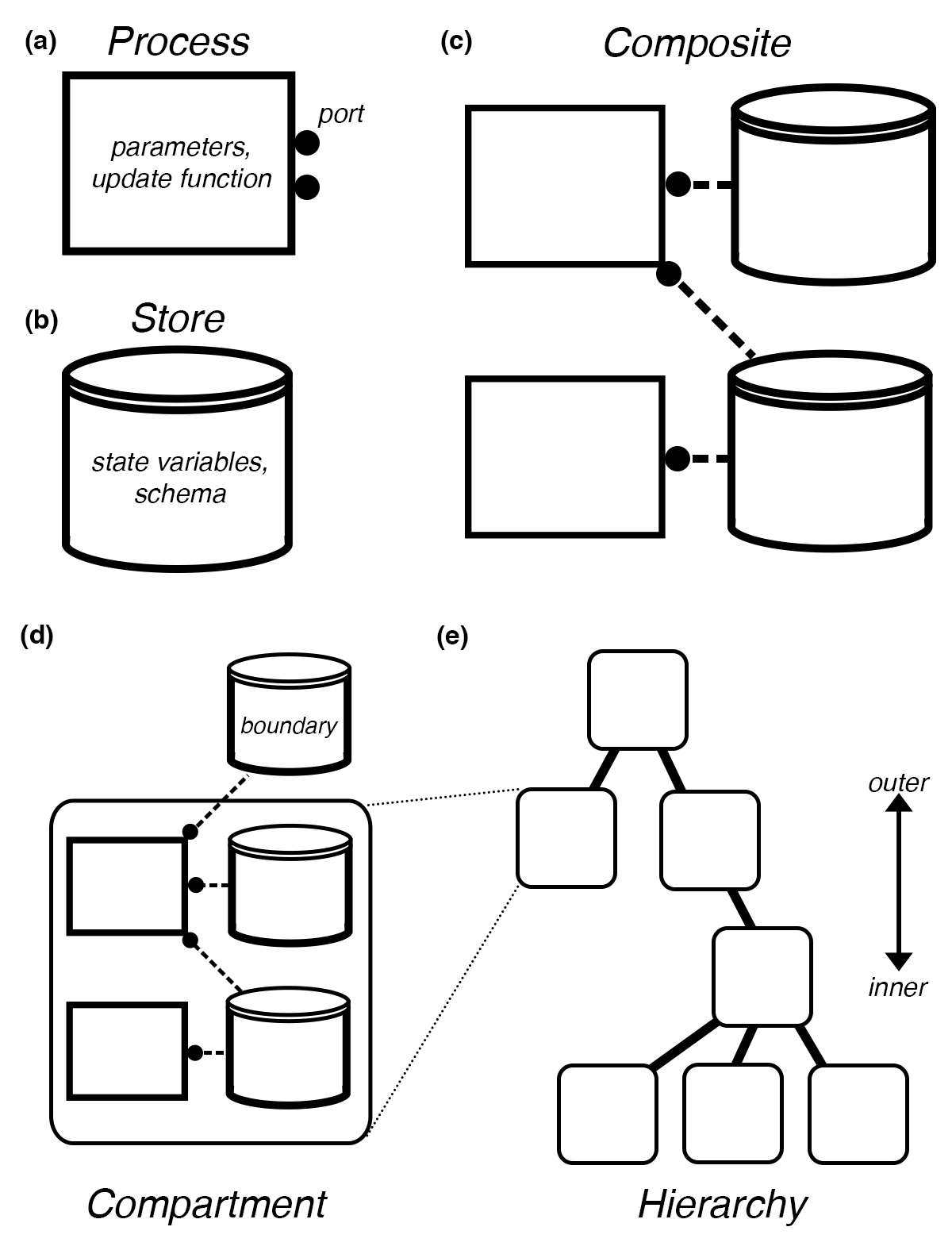Engine for composing and simulating computational biology models with the Vivarium interface.
Project description
Vivarium Core
Vivarium Core provides a process interface and simulation engine for composing and executing integrative multi-scale models.
Getting Started
Vivarium Core is available on PyPI here, and can be installed as a python library like this:
$ pip install vivarium-core
To get started using Vivarium Core, see our documentation and tutorial notebooks.
If you want to contribute to Vivarium Core, see our contribution guidelines.
Concept
Computational systems biology requires software for multi-algorithmic model composition, which allows many modeling efforts to be extended, combined, and simulated together. We need an "interface protocol" -- analogous to TCP/IP for the Internet -- which allows diverse pieces of simulation software to connect, communicate, and synchronize seamlessly into large, complex, and open-ended networks that anyone can contribute to.
Vivarium addresses the challenges of model reuse and multi-scale integration by explicitly separating the interface that connects models from the frameworks that implement them. Vivarium's modular interface makes individual simulation tools into modules that can be wired together in composite multi-scale models, parallelized across multiple CPUs, and run with Vivarium's discrete-event simulation engine.
The figure below illustrates the key terminology of Vivarium's interface.
- (a) A Process, shown as a rectangular flowchart symbol, is a modular model that contains parameters, an update function, and ports.
- (b) A Store, shown as the flowchart symbol for a database, holds the state variables and schemas that determine how to handle updates.
- (c) Composites are bundles of Processes and Stores wired together by a bipartite network called a Topology, with Processes connecting to Stores through their ports.
- (d) Compartments are Stores with inner sub-Stores and Processes. Processes can connect across compartments via boundary stores.
- (e) Compartments are embedded in a Hierarchy -- depicted as a place network with discrete layers, with outer compartments shown above and inner compartments below.

License
Copyright (C) 2019-2022 The Vivarium Authors
Licensed under the Apache License, Version 2.0 (the "License"); you may not use this project except in compliance with the License. You may obtain a copy of the License at http://www.apache.org/licenses/LICENSE-2.0.
Unless required by applicable law or agreed to in writing, software distributed under the License is distributed on an "AS IS" BASIS, WITHOUT WARRANTIES OR CONDITIONS OF ANY KIND, either express or implied. See the License for the specific language governing permissions and limitations under the License.
See LICENSE.txt for a copy of the full license, and see
AUTHORS.md for a list of the Vivarium Authors.
Project details
Release history Release notifications | RSS feed
Download files
Download the file for your platform. If you're not sure which to choose, learn more about installing packages.
Source Distribution
File details
Details for the file vivarium-core-1.2.5.tar.gz.
File metadata
- Download URL: vivarium-core-1.2.5.tar.gz
- Upload date:
- Size: 120.7 kB
- Tags: Source
- Uploaded using Trusted Publishing? No
- Uploaded via: twine/3.8.0 pkginfo/1.8.2 readme-renderer/34.0 requests/2.27.1 requests-toolbelt/0.9.1 urllib3/1.26.8 tqdm/4.63.0 importlib-metadata/4.10.1 keyring/23.5.0 rfc3986/2.0.0 colorama/0.4.4 CPython/3.8.9
File hashes
| Algorithm | Hash digest | |
|---|---|---|
| SHA256 | 7c0c341938fe32cd6331bcdd61dae9f95da57f6c4e1e5dd7a1e2a86f4569062f |
|
| MD5 | 6221a11922771d13bd1bf0520e224138 |
|
| BLAKE2b-256 | df4b71dd024fdc255d32780c9e7c3c46b9f8d381d13160b1b6e1e4000b95e9fe |


















